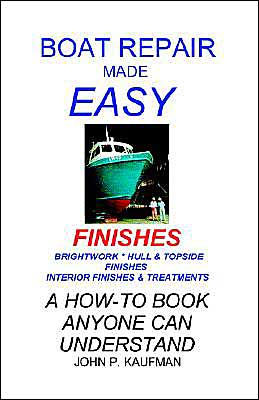Read an Excerpt
EXCERPT: From Chapter One: Before you can begin the application of a finish to any surface, you must have properly prepared surface. Most boats have some unwanted water penetration and this problem must be addressed before the paint can be applied. I firmly believe all the sealants used on a boat should be protected by the final coating. It then becomes obvious, to achieve this, the sealants must be applied before the finish. Therefore, I will start with the selection and application of the correct sealant for the intended use.
The first step in applying a caulk or sealant in the marine environment is to determine which of the three basic types of products are best suited to the job. Listed below are each of the basic caulk and sealant types accompanied by a brief description of the physical and chemical characteristics. Based on these characteristics, suggested uses are provided.
Silicone: Silicone caulking is an extremely durable, chemically inert (does not react with most other chemicals) product which stays soft and pliable over a large span of temperature, and humidity conditions. It does not have a great amount of adhesive property, therefore it should not be used where contribution to structural integrity is required.
Pure silicone caulk cannot be sanded once it cures, so all tooling and cleanup must be done immediately after application. When silicone caulking needs to be removed, it can be cut away with a knife and the remaining material rubbed or abraded off or out of the joint. The above properties make silicone an excellent choice for bedding cleats and related deck hardware which more than likely will need periodic replacement. Pure silicone specially manufactured for marine use, such as Starbrite Marine Silicone Sealant, GE 100% Silicone and West Marine Silicone, can be used underwater in a compression gasket application. This process will be described later. Silicone is also the sealant of choice to fill channels in which glass windows or hatches are fitted. Inside the cabin, silicone is excellent for a general purpose sealant around tub, shower, galley, and lavatory areas.
Polysulfide: Polysulfide is an excellent adhesive type sealant which can withstand a great amount of flexing. It bonds extremely well to oily woods, such as teak. Polysulfide caulking may be used above and below the waterline to seal wood seams, as well as joints where wood butts up to fiberglass, plastic, glass or metal. Once it cures, the material may be sanded and painted, therefore immediate tooling, finishing and cleanup is not a necessity. The word polysulfide may not be in the product's name (i.e., Starbrite Boat Caulk, 3M 101 Marine Sealant) so look for the name on other areas of the tube or cartridge you purchase, to insure that you are getting the desired product.
Polyurethane Adhesive/Sealants: Polyurethane (Starbrite 8200, 3M 5200, others are available, but hard to find in most stores) is a very strong adhesive with relatively little flex, or give, once it cures. These properties make it excellent for joints where additional structural integrity is desired. Because it is such a strong adhesive, removal of old sealant is extremely difficult. For this reason you would not want to use polyurethane sealants on seams or as a bedding for materials that will need periodic replacement such as deck seams, hardware, port holes, window trims, etc. Once the material fully cures, a chisel is literally required to separate joined surfaces. Polyurethane sealant is excellent for bedding bait wells, deck to hull seams, bulkhead seams, struts and other permanent installations.
For general seams, remove all traces of previously applied sealant. This can be accomplished by sanding or with the use of a knife or chisel. The seam should then be cleaned with a quick drying solvent such as MEK (methyl ethyl ketone) or acetone. These solvents can attack the paint and plastics, so extreme care is required to keep them off surrounding surfaces. If protection to surrounding surfaces is needed, use 6 or 8 mil plastic sheeting, taped well into place. If dirt or dust is present in the seam, it should be thoroughly vacuumed and washed out with soap and water. The seam to be caulked must be completely dry and free of any loose debris.




